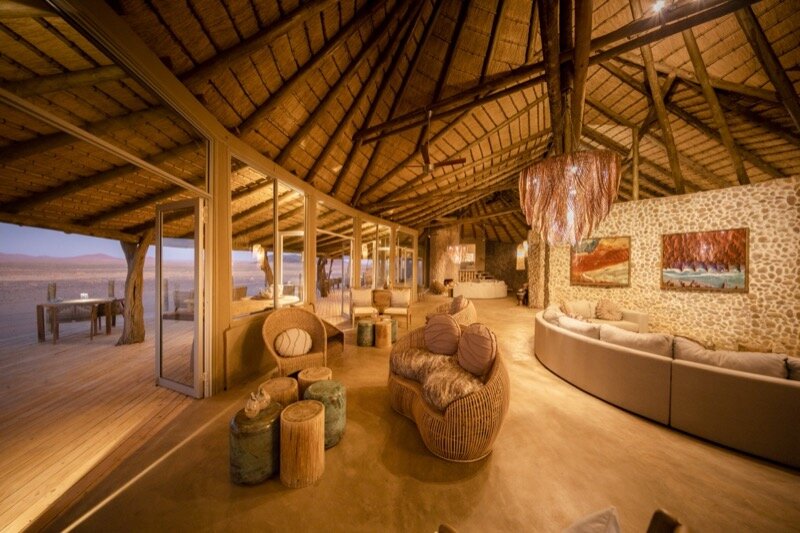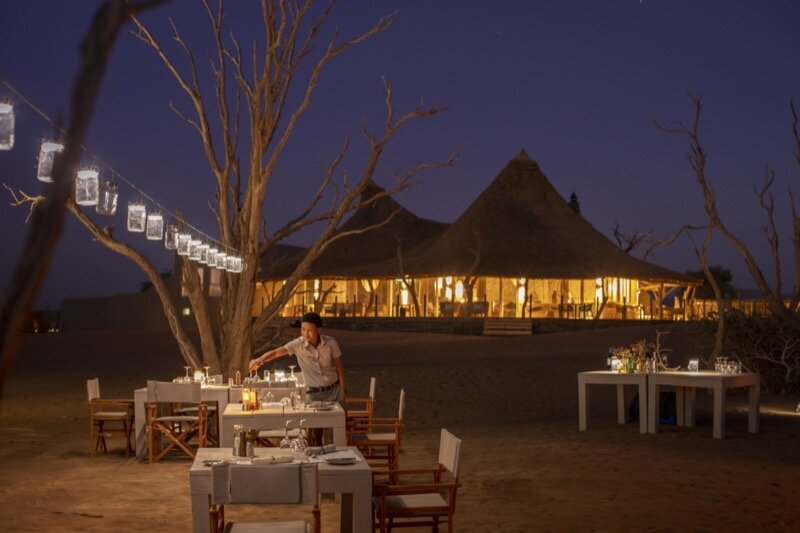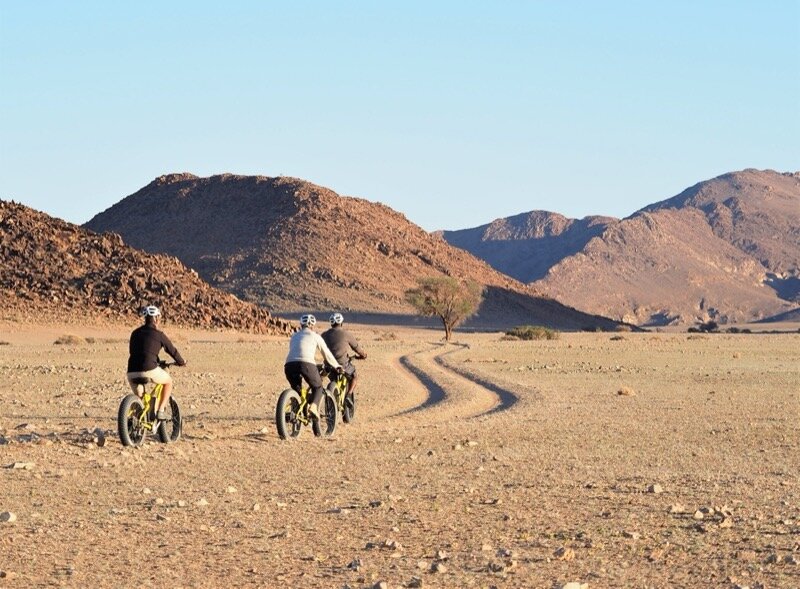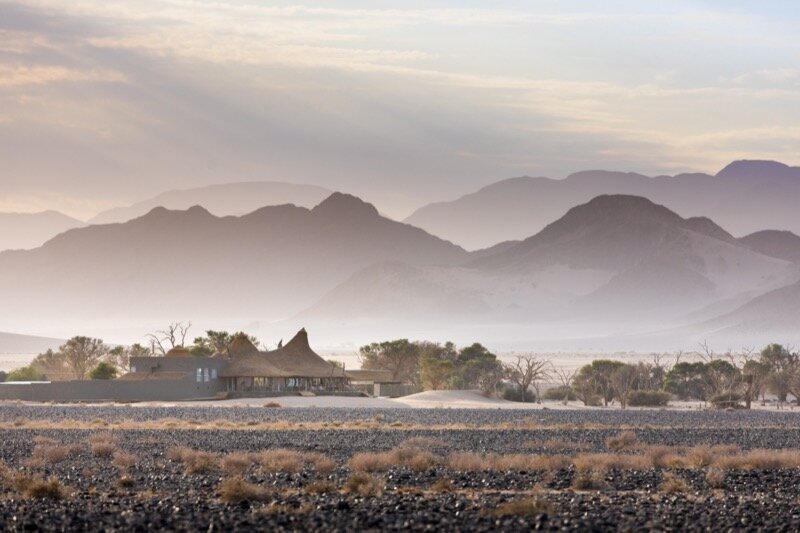Under the Namibian Sky
Alexandra Delf took a pre-covid trip to Little Kulala to take in the stunning views and nature of Namibia
The night sky has never seemed so expansive, gazing in awe from a star bed in the middle of the Namib Desert. The vast blanket of space brings with it a newly found appreciation of the huge, open, star filled skies and expanding horizons that as city dweller, can never be found.
A Namibian adventure means space and a lot of it, from wild rocky terrain as far as the eye can see, to the shifting red sands, endless desertscapes and Skeleton Coast the country is known for. Being surrounded by such incredible wild landscapes, also brings a feeling of living life on the edge. Experts such as Wilderness Safaris have recognised and created oases of comfort, from which to enjoy the raw powerful beauty of nature this region has to offer. One such oasis is Little Kulala, situated in the 27 000-hectare Kulala Wilderness Reserve, offering access to the bucket list encounters in the region, such as Sossusvlei and Deadvlei. For time poor travellers, as with
many properties throughout Namibia, nearby access to an airstrip is available. A large proportion of travellers choose to experience an itinerary via local flights to see as much as possible. On expert recommendation, we chose a road trip, allowing us to take in the stunning views and nature of Namibia up close and personal.
Each suite at Little Kulala comes complete with its very own serene starbed and spending as much time in the desert air as possible is actively encouraged, from stargazing to private rooftop dinners. Immersive dining comes complete with interactive storytelling bound to captivate, whereas dining in the wine cellar allows complete privacy and a vast selection of wines, tempting to try at such close proximity. Since our visit Little Kulala has been renovated and re-opened, including the launch of a range of mindful elements, such as all-new spa and farm-to-table menus. Local produce is key from the use of mogau oshi, an organic Namibian wild spinach that tastes like Swiss chard, to locally grown Rooibos tea.
Arriving into Little Kulala after several hours of driving was a welcome delight. Not only was the accommodation breath taking, set within the sweeping red desert, but the opportunities to get out and explore immediately were plentiful. At least 55 million years old, the Namib desert is considered the oldest in the world, home to San Rock Art and rare desert adapted species. Little Kulala activities range from exhilarating rides on eco-sensitive quad-bikes, self-guided or guided trails on foot or on fat bikes and immersive desert adventures to engage with endemic animals. One of the most popular activities is climbing Big Daddy, the tallest dune in the Sossusvlei area at 325 meters, not for the faint hearted but highly recommended. Starting early meant a cooler climb, which definitely helped and the spectacular views from the top made it worth every step up the shifting sands. The experience of ‘skiing’ down the dunes barefoot was unexpected and exhilarating and almost made me want to do a second climb back up again.
However, with so much more to fit in, we pressed on to the iconic Dead Vlei, which was extremely busy, packed with tourists. One of the most popular areas to visit in Namibia, the striking landscape of blue sky, bleached clay pans and the skeletons of 900-year-old camelthorn trees, creates a photographic sensation visitors flock to capture. A visit at sunrise before the tourists arrived would I am sure, provide a more magical encounter of this astonishing location. A lone Oryx cuts a dark silhouette against the dunes, a striking figure, iconic of the region and Namibia’s national animal, a key example of one of Namibia’s desert adapted animals who have learnt to survive despite the harsh conditions.Nature is in absolute control here, footsteps on the dunes are swept away through the day, leaving them as pristine as ever for the arrival of the next explorers. When the wind picks up, the red sand is whipped into a frenzy and impossible to avoid. Driving across this difficult terrain is only manageable with a sturdy 4x4 and a steady hand. We didn’t experience desert storms frequently but when we did, the awesome power of nature and its hold over the region was irrefutable. However, even in such dry and inhospitable circumstances, life has adapted and survived and, in some cases thrived.
Animal lovers visiting Namibia may need to adapt their expectations, this is not the land of The Big Five but The Little Five. Not quite as fearsome as their larger namesakes, depending on any phobias of course, Namibia’s Little Five include lizard, snake, gecko, chameleon and spider. The name Namib means ‘an area where there is nothing’ in local Nama and at a first glance down from an aerial view, the name seems incredibly apt. Flying across the dunes to see the iconic Skeleton Coast, the wild and untamed terrain below provides little evidence of life, apart from the large colonies of seals which line the coast. The coast takes its name from the skeletons of many ships abandoned in the shallow waters across hundreds of years, as well as the abundance of animal bones. The name paints an accurate portrait of the untameable yet mystical natural landscape below. Hidden diamonds, dunes and shipwrecks, all make for a fantastical feeling of otherworldly adventure. Even on a self-drive trip, the air offers an incredible perspective to take in the wild beauty of the Skeleton Coast and can be easily included in a morning or afternoon itinerary. Back down to earth, a guided tour of this same arid sandscape soon reveals what lies beneath, and it’s teeming with life, including the Namibian Little Five and more. Living Desert Adventures is led by extremely energetic environmentalist and Namibia expert, Chris Nel. An engaging and passionate approach brought the discovery of creatures in the Dorob National Park to life, from the rainbow hued sand-diving Palmato Gecko to the black Desert Chameleon. Each tiny creature was lovingly explained along with detailed insights of the desert eco-system.
If the Little Five don’t quite fit the bill, there are options which allow up close and personal experiences with animals of a larger kind, which have evolved and adapted to conditions in Namibia. Many desert adapted animals can be found across the country, from rhino and elephant to lions and horses. That is, if you know where to look and have the time, patience and stamina to find them. We were lucky enough to come across both desert adapted rhino and elephant after a substantial search. Unlike safari in well-known locations such as bordering South Africa or Botswana, numbers of such animals are small and the areas they inhabit are large and difficult to navigate, even with the help of trusted guides. We didn’t make it to Etosha National Park, but for big game viewing, those in the know recommend it as the place to tick off most of The Big Five with ease.
From the wild Atlantic coastline to the miles of red desert or rugged rockscapes, be prepared to feel insignificant and in awe of the vastness of the natural surroundings. The driving element definitely allowed us to feel the magnitude off the Namibian wilderness, encountering no signs of life despite driving for several hours each day through beautiful alien panoramas. For the time poor, flying would be key to fit in an introduction to everything this incredible country has to offer. However, if you can take the time, the self-drive option, although longer and harsher, allows you to experience the ever-changing terrains and finer details that make this experience so unique. Namibia was unexpected, raw, powerful and beautiful, a totally different side of Sub-Saharan Africa to the one I had previously had the pleasure of exploring and dream of visiting again in the future.
At this time, when we are all staying closer to home, taking inspiration from YouTube videos of starry Namibian skies, doesn’t quite live up to stargazing from a place of such splendour and solitude.
For more information visit wilderness-safaris.com or namibiatourism.com.na
Hungry for more?
Read up on the latest news, delicious eats, travel treats and seasonal style trends in FEATURES, or browse a curated selection of our FEATURED PRODUCTS, meander through our guide to the finest things to do in Cheshire and beyond in WHATS ON or partake in our COMPETITIONS.
About The CHESHIRE Magazine
We are the definitive guide to luxury lifestyle in the North West. Latest news, delicious eats, travel treats and seasonal style trends. The Cheshire Magazine is the largest luxury lifestyle title for the North West of England, dropping directly through the letterboxes of VIP subscribers from the Wirral to Greater Manchester plus all the villages and towns in between and digitally available as a subscription in print and digital on issuu.com worldwide. We specialise in connecting luxury brands to likeminded consumers.
If you are interested on how you can partner with The CHESHIRE Magazine, read more about us. Or get in touch to find out more about marketing, featuring or partnering with the Cheshire Magazine in print or online.

















